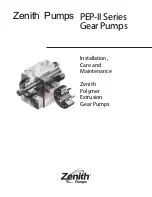
Installation instructions geoTHERM 0020051574_04
7
a
Safety instructions and regulations
a
2
>
Keep away from heat, sparks, naked flames and hot sur-
faces.
>
Ensure that there is sufficient ventilation in the event of
accidental release.
>
Avoid the accumulation of steam/air mixtures. Keep
brine fluid containers closed.
>
Observe the safety data sheet that accompanies the
brine fluid.
The components of the heat pump can reach high tempera-
tures.
>
Do not touch any uninsulated pipelines in any part of the
heating installation.
>
Do not remove any cladding parts.
Preventing electric shocks
>
Always switch off all power supplies at all poles before
carrying out any electrical installation or servicing work.
>
Check that there is no voltage.
>
Make sure that they are secured against inadvertent
switching on again.
Preventing chemical burns
Brine fluids are harmful to health.
>
Avoid contact with the skin and eyes.
>
Do not inhale or swallow.
>
Always wear gloves and protective goggles.
>
Observe the safety data sheet that accompanies the
brine fluid.
Preventing damage
Unsuitable frost or corrosion protection agents may dam-
age seals and other components
of the heating
circuit
and may therefore also cause leaks in the water out-
let.
>
Only add permitted frost or corrosion protection agents
to the heating water
VWW only:
If the water is of poor quality, this may lead to damage to
the suction well, the pipes and the evaporator in the water
pump.
>
Check that the quality level of the water that is drawn in
is sufficient.
VWS only:
Frost may cause damage to seals and other components
of
the brine circuit
.
>
Add permitted frost protection agents that ensure frost
protection up to - 15 °C to the brine fluid
(
¬
Ch. 6.3
)
.
If external passive cooling is installed:
If the pipes of the heating circuit are not sufficiently insu-
lated and if the flow temperatures are below 20 °C, this
may cause the cooling to fall below the dew point and may
lead to condensation forming.
>
Insulate all of the pipes in the heating circuit using
vapour diffusion-tight insulation.
>
Do not set the heating flow temperature too low during
cooling.
During cooling, condensation forms on the radiators and
their supply lines and this causes mould to form and struc-
tural damage.
>
Do not install the geoTHERM heat pumps with external
passive cooling in heating installations that have radia-
tors.
i
Using surface collectors disrupts the cooling
function.
When using a Vaillant heat pump with external
passive cooling, ground sensors must be used.
Preventing environmental hazards (VWS only)
The brine fluid that is contained in the heat pump must not
reach the drainage system, surface water or groundwater.
>
Dispose of the brine fluid that is in the water pump in
compliance with local regulations.
2.4
Safety instructions regarding coolant
Preventing freezing
The heat pump is delivered with an operational filling of R
407 C coolant. This is a chlorine-free coolant which does
not affect the Earth’s ozone layer. R 407 C is neither a fire
hazard nor an explosion risk.
With normal use and normal conditions, the coolant
R 407 C poses no risk. However, damage may occur in the
event of improper use.
Escaping coolant can cause freezing if the exit point is
touched:
>
If coolant escapes, do not touch any components of the
heat pump.
>
Do not inhale any steam or gases that escape from the
coolant circuit as a result of leaks.
>
Avoid skin and eye contact with the coolant.
>
In the event of skin or eye contact with the coolant, seek
medical advice.
Preventing environmental hazards
The heat pump contains the coolant R 407 C. The coolant
must not be allowed to escape into the atmosphere. R 407 C
is a fluorinated greenhouse gas covered by the Kyoto Proto-
col, with a GWP of 1653 (GWP = Global Warming Potential).
If it escapes into the atmosphere,
its impact is 1653 times stronger than the natural green-
house gas CO
2
.
Before disposing of the heat pump, the coolant that is con-
tained in the heat pump must only be drained via service
valves into a recycling cylinder. In the case of service work,
new coolant (for the quantity, see the identification plate)
(
¬
Ch.
3.1
) must only be poured in via service valves. If an
approved replacement coolant other than the R 407 C that
is recommended by Vaillant is poured in, not only do all
guarantees lose their validity, but the operational safety can
also not be guaranteed.








































